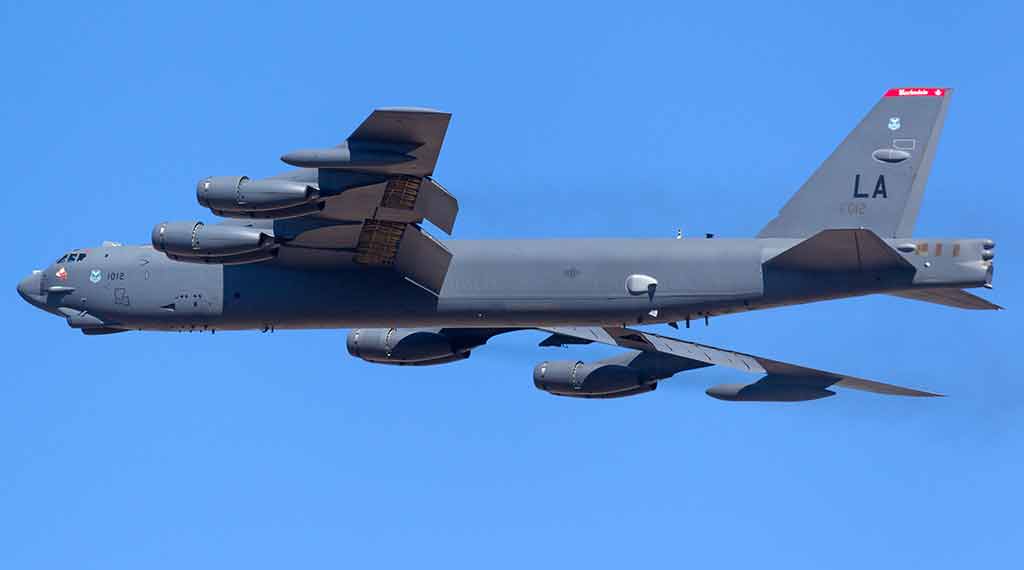B-52J: The B-52 ‘Stratofortress’ bomber could fly for 100 years

The B-52 Stratofortress, a legendary U.S. Air Force strategic bomber, continues to serve over 70 years after its first flight. The upcoming B-52J variant marks the most significant upgrade in the aircraft’s history, including new Rolls Royce F130 engines, enhanced avionics, and improved digital displays.
-The B-52J will also carry advanced weapons like the hypersonic attack cruise missile (HACM).
-Despite only 10% of the original fleet remaining, the B-52J will ensure the Stratofortress continues its critical role into the mid-21st century, potentially surpassing 100 years of service.
B-52J: The Stratofortress’ Biggest Upgrade Yet
More than 70 years ago, the legendary B-52 strategic bomber first took to the skies for the U.S. Air Force. This long-range, subsonic aircraft may be rapidly aging, but the Air Force is nowhere near pushing it out of service. In fact, the Stratofortress will continue serving into the mid-21stt century. It might pass the century mark before it is finally retired.
The service plans for a fleet in the next decade that will include 76 newly upgraded B-52s and at least 100 next-generation B-21 Raiders. And the latest B-52 variant will represent the biggest upgrade in the history of the Stratofortress.
Perhaps the B-52J variant’s most meaningful upgrade is the replacement of its engines. According to Air and Space Forces Magazine, “Any B-52H aircraft modified with the new commercial engines and associated subsystems are designated as B-52J.”
The first B-52s ran on Cold War-era Pratt & Whitney TF33 engines. The Air Force will now fit new Rolls Royce-made F130 engines to the B-52Js as part of its Commercial Engine Replacement Program. The upgraded bomber will also receive improved avionics, new digital displays, and the Long Range Standoff weapon.
An Overview of the B-52J Bomber
The Air Materiel Command first specified requirements for a new bomber platform two months after the end of the Second World War. In order to achieve air superiority, the service wanted the new aircraft to cruise at a speed of at least 300 miles per hour, with a combat radius of 5,000 miles, in addition to being able to lug hefty armaments.
Proposals came from a number of the big-name manufacturers of the time, including Boeing, Glenn L. Martin Company, and Consolidated Aircraft. Ultimately, Boeing’s design was selected, and the B-52 first flew in the late 1950s. The bomber was designed to overwhelm Soviet defenses with its high speed and advanced electronic countermeasures.
Over the years, several Stratofortress variants were introduced. The B-52H is the Air Force’s latest model, equipped with a larger payload and longer range. Nicknamed the Buff (big ugly fat fellow), the B-52H is the service’s primary strategic nuclear and conventional weapons platform.
This variant debuted in 1961. In the early 2000s, Boeing was awarded a contract to design and develop a combat network communications technology program, known as CONECT, which provides network-centric operational capability. This important feature was complemented by the inclusion of greater arms-carrying capacity. As explained by Air Force Technology, the B-52H can carry more than 70,000 pounds of diverse weapons. This variant can lug AGM-84 Harpoon missiles, AGM-86A air-launched cruise missiles, Joint Direct Attack Munitions, and numerous other weapons.
The upcoming B-52J will be even more powerful. The bomber’s engine will include a new power generation system that will provide a 30% gain in fuel efficiency. Weapons-wise the bomber was first intended to carry the hypersonic AGM-183 Air-Launched Rapid Response Weapon. However, it appears that the Air Force is nixing this program and prioritizing the hypersonic attack cruise missile (HACM) going forward.
As detailed by Breaking Defense, “HACM is an air-breathing, scramjet-powered cruise missile that can fly at speeds greater than Mach 5 and maneuver on the way to its target, making it harder for adversaries to shoot it down. The Air Force awarded RTX subsidiary Raytheon a contract for the weapon in 2022 with a scramjet to be supplied by Northrop Grumman. The HACM draws from previous work done with DARPA and continues a partnership with Australia. The service has previously said it wants to field the weapon by FY27.”
Although only about 10% of America’s 744-strong B-52 bomber fleet remains in service today, these airframes continue to play an outsized role in the Air Force. Considering the improvements planned for the B-52J, the Stratofortress is well positioned to serve for decades to come.
- Iran’s Growing Missile Arsenal Is a Challenge for Israel - November 18, 2025
- IAI Is Hoping to Secure a Contract for the “Golden Dome” - November 3, 2025
- Trump dispatches B-1 bombers and other military assets to Venezuela - October 28, 2025
